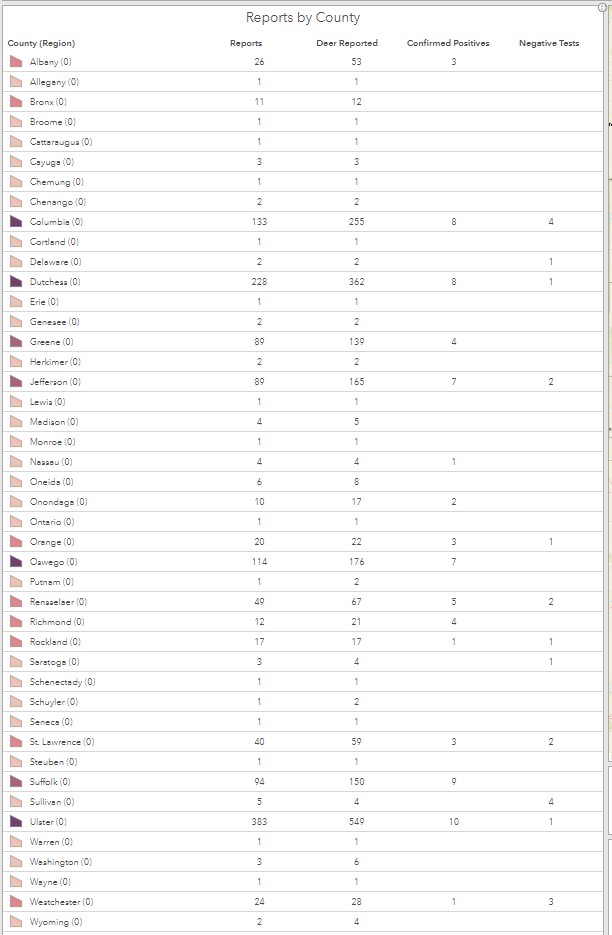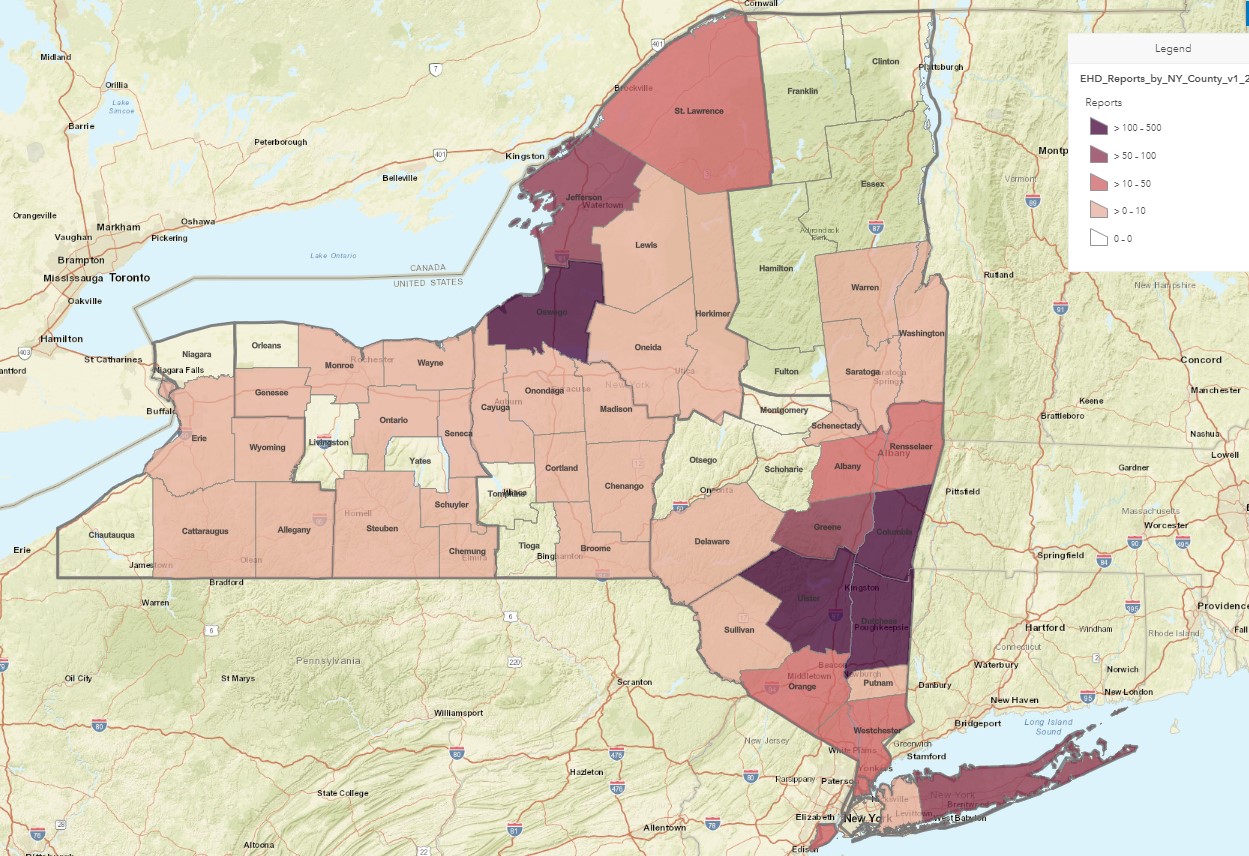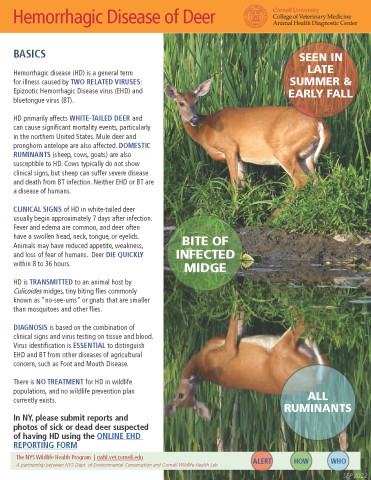Current status of EHD in NYS (Updated Oct 2, 2025)
We've had one positive case of EHD in Niagara County. A dead male deer was found at the edge of a pond, appearing normal. Samples were submitted within 24 hours for diagnostic testing, confirming EHD.
Ongoing EHD Research Study
The NYS Wildlife Health Program has an ongoing research project that has been testing blood samples from hunter-harvested deer since 2021 and will continue through this hunting season. Thus far, we have seen that some NY deer exposed to the EHD virus are capable of surviving. We found areas across central and eastern NY where deer were infected, but no deer mortality was noted.
Please visit the DEC webpage on EHD for more information: https://www.dec.ny.gov/animals/123773.html.
Submit reports and photos of sick or dead deer suspected of having EHD using the Online EHD Reporting Form (link leaves site).
What is EHD?
EHD virus is an often fatal disease of deer that is transmitted by biting midges, small bugs often called no-see-ums or 'punkies.' The disease is not spread from deer to deer and humans cannot be infected by deer or bites from midges.
Once infected with EHD, deer usually die within 36 hours. EHD outbreaks are most common in the late summer and early fall when midges are abundant. EHD symptoms include fever, hemorrhage in muscle or organs, and swelling of the head, neck, tongue, and lips. A deer infected with EHD may appear lame or dehydrated. Frequently, infected deer will seek out water sources and many succumb near a water source. There is no treatment or means to prevent EHD. The dead deer do not serve as a source of infection for other animals.
EHD outbreaks occur sporadically and deer in New York have little immunity to this virus. Consequently, most EHD-infected deer in New York are expected to die. In the north, the first hard frost kills the midges that transmit the disease, ending the EHD outbreak.
The EHD virus was first confirmed in New York in 2007 with relatively small outbreaks in Albany, Rensselaer, and Niagara counties, and in Rockland County in 2011. From early September to late October 2020, a large EHD outbreak occurred in the lower Hudson Valley, centered in Putnam and Orange counties, with an estimated 1,500 deer mortalities.
Historical EHD Case Information
2024: 1 death reported
The DEC is currently monitoring a potential outbreak of EHD affecting the lower Hudson Valley, which began in Orange County in mid-August 2024; only one case has been confirmed as positive for EHD.
2023: 0 deaths reported*
We had no positive cases of EHD in 2023. We did have one positive case of BTV.
2022: 150 deaths – EHDV serotype 2. Bluetongue virus was identified in NY for the first time.
Updated Sept. 20, 2022
First Detection of Blue Tongue Virus in Deer in New York
The New York State Department of Environmental Conservation (DEC) today reported three deer in Southampton, Suffolk County, tested positive for bluetongue, which is closely related to the Epizootic Hemorrhagic Disease (EHD) virus and is transmitted in the same way. This is the first time the bluetongue (BT) virus was detected in New York deer. It was detected in several other mid-Atlantic coast states this year. For more information, please visit DEC at https://www.dec.ny.gov/press/126187.html
Diseases are Not Transmissible to Humans or Pets; New Yorkers Encouraged to Report Sick or Dead Deer (link below)
First Positive Case of EHD Reported in Dutchess County for 2022 Season
A deceased doe was reported by a homeowner laying alongside a stream in eastern Dutchess County late last week. DEC biologists collected the carcass and were also informed another deer, a buck, had been found deceased on a neighboring property recently. Samples were collected from the doe and submitted to the Cornell Wildlife Health Lab at the AHDC for PCR testing and the results were positive for the epizootic hemorrhagic disease (EHD) virus. This is the first case of the 2022 season, EHD outbreaks are most common in the late summer and early fall. A second deer was reported and tested positive for EHD on August 17, also in Dutchess county.
2021: 2,156 deaths reported – EHDV serotypes 2 and 6
Updated January 11, 2022
In 2021, the first EHD positive was reported in . After this point, the NYSDEC received reports from the public on an additional 2,156 presumed deer that appeared sick or recently deceased. THe NYSDEC continued receiving reports and testing deer for EHD in counties in which the disease was previoulsy unconfirmed in 2021. The table and map below describe the extent of reports and testing during 2021.
2020: 1,500 deaths reported
October 30, 2020 - EHD expanding to new states & serotyping strains
According to the Southeastern Cooperative Wildlife Disease Study, two serotypes of the EHD virus have been identified in multiple states. EHDV-6 has been identified in New York, as well as DE, GA, IN, KY, MD, NC, PA and WV. EHDV-2 has been identified in IN, KY, MO, MT, NE, NC, ND, TN, VA, and WI.
Positive cases of EHD in zoos are also being reported: Seasonal disease kills 4 reindeer at Minnesota Zoo, sickens 4 others
October 2, 2020 - Increase in EHD suspect deer mortalities
The majority of reports of EHD-suspected mortality are coming from Putnam, eastern Orange, southern Ulster, northeastern Rockland, and northwestern Westchester Counties. Total reports reflect there are approximately 750 deer mortalities in these areas.
DEC has issued a press release with information and guidelines on what hunters may see in the field and what steps they should take. Please visit DEC for more information. DEC Press Release: DEC Asks Bowhunters to Report Deer that May Have Died from EHD
Below is the current list of towns with diagnostically confirmed EHD positive deer. Please also consider any location within 10 miles of a known case to be part of the outbreak area. There are numerous reports of EHD-suspect deer from towns not on this list.
- Dutchess:
- Hyde Park
- East Fishkill
- Wappinger
- Pawling
- Putnam:
- Phillipstown
- Putnam Valley
- Westchester:
- Cortlandt
- Ulster:
- New Paltz
- Wallkill
- Orange:
- Montgomery
- Newburgh
- Goshen
- Greene:
- Catskill
September 3, 2020 - Additional states reporting EHD-positive deer
Reports of positive deer in VA, WV, and OH with suspect cases reported in NJ. PA Department of Agriculture has confirmed EHD in a deer from a captive facility in Crawford County in the NW region.
September 2, 2020 - 6 EHD-positive deer identified in southeast New York State
New York State Department of Environmental Conservation has confirmed epizootic hemorrhagic disease (EHD) in two white-tailed deer from Putnam county and four white-tailed deer in Orange county. Please contact the DEC to report sick or dead deer, particularly if there is more than one deer in an area or the deer is near water.
2017
September 27, 2017 - more states reporting EHD
PA, OH, MD, MI, CT, WV, KY, TN, and Ontario are all reporting EHD. PA has confirmed both EHD subtypes 2 and 6 in the state. PA and DE are asking the public to be alert for the disease. Results are pending from North Carolina and Virginia; testing was conducted at the Southeast Cooperative Wildlife Disease Study.
August 18, 2017 - Requests for public to be on alert for the disease in PA and DE
This is the first case in domestic livestock so far this year. Jefferson Co. borders the little piece of WV that sticks up between OH and PA. PA has reported EHD in a white-tailed deer in Beaver Co., which is very close to Jefferson Co. OH.
In deer, the symptoms of EHD include fever; small hemorrhages or bruises in the mouth and nose; and swelling of the head, neck, tongue, and lips. A deer infected with EHD may appear lame or dehydrated. An infected deer may die within 1-3 days after being bitten by the midge or the disease may progress more slowly over weeks or months. Frequently, infected deer will seek out water sources and carcasses are often found near water. Often, a large number of dead or sick deer are found in a limited area. There is no treatment and no means of prevention for EHD. The dead deer do not serve as a source of infection for other animals because the virus is not long-lived in dead animals.
EHD does not infect humans, and generally causes mild or inapparent infections in domestic cattle and small ruminants. Another similar virus called Blue Tongue can also infect deer, which is very difficult to tell apart from EHD without laboratory testing.









